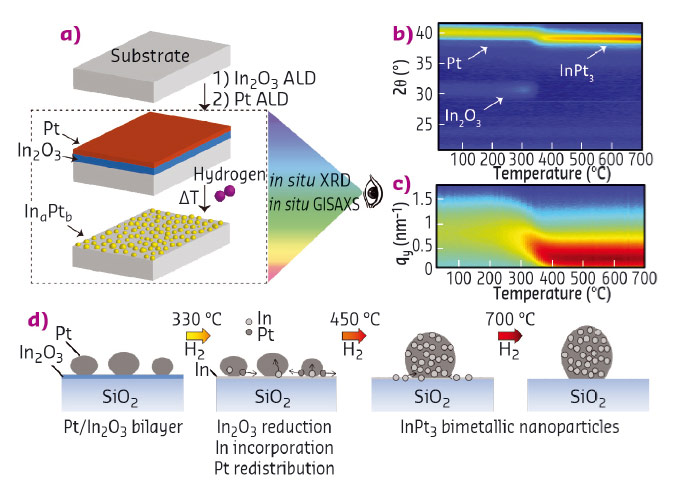- Home
- Users & Science
- Scientific Documentation
- ESRF Highlights
- ESRF Highlights 2016
- Complex systems and biomedical sciences
- Synthesis of bimetallic nanoparticles with tailored size and composition
Synthesis of bimetallic nanoparticles with tailored size and composition
A novel recipe based on atomic layer deposition has been established for the fully-tailored synthesis of supported Pt-In bimetallic nanoparticles. The combination of in situ X-ray diffraction and in situ grazing-incidence small-angle X-ray scattering measurements revealed the mechanism of bimetallic nanoparticle formation.
Bimetallic nanoparticles play a pivotal role in optical, magnetic and electronic applications, and are true workhorses during the catalytic transformation of chemicals. In particular, supported Pt nanoparticles alloyed with In, Ga or Sn are highly selective catalysts for the dehydrogenation of propane to propylene. It is well established that the size and composition of the nanoparticles strongly impact the catalytic properties and performance. Yet, conventional synthesis strategies lack proper control over the nanoparticle morphology and composition.
 |
|
Fig. 112: a) ALD-based Pt-In bimetallic nanoparticle synthesis. b) In situ XRD patterns measured during TPR in hydrogen. c) In situ GISAXS line profiles measured during TPR in hydrogen. d) Bimetallic nanoparticle formation mechanism as interpreted from in situ XRD and GISAXS. |
We report a new procedure for the tailored synthesis of bimetallic nanoparticles containing a non-noble metal next to a noble metal, here exemplified for nanoalloys containing In as non-noble and Pt as noble metal. The recipe is based on the use of atomic layer deposition (ALD), a vapour phase deposition method that is characterised by alternating exposure of the sample to chemical precursors [1]. ALD ensures that the amount of deposited material can be controlled at the monolayer level and enables conformal depositions on 3D substrates. Figure 112a schematically describes the steps involved in the fabrication process of the Pt-In bimetallic nanoparticles. Thin layers of In2O3 [2] and Pt are sequentially deposited by ALD, yielding a Pt/In2O3 bilayer structure. These bilayers are then subjected to a temperature programmed reduction (TPR) in hydrogen to induce the formation of Pt-In nanoalloys.
Using in situ X-ray diffraction (XRD) at UGent and in situ grazing-incidence small-angle X-ray scattering (GISAXS) at beamline BM26 (Dubble CRG), the mechanism of bimetallic particle formation was studied in detail. Figure 112b shows the structural evolution of a Pt/In2O3 bilayer during TPR in hydrogen as measured with XRD. Initially, the pattern shows diffraction from In2O3 (222) and metallic Pt (111). The disappearance of the In2O3 (222) peak around 330°C is indicative of complete reduction of the In2O3 layer. The In2O3 reduction is accompanied by a shift of the Pt (111) diffraction towards lower 2θ angle, implying expansion of the Pt fcc lattice due to insertion of In into the Pt structure. The stabilisation of the shifted diffraction peak indicates the formation of an InPt3 fcc alloy. The evolution of the nanoscale morphology of the sample during TPR was monitored with in situ GISAXS. The temporal evolution of the main scattering feature is visible in the 2D colour plot in Figure 112c. A stable scattering pattern is observed up to 300°C, followed by a gradual peak shift to lower qy-values until 450°C. These results indicate that the insertion of In in the Pt fcc lattice, as monitored by XRD, is accompanied by the migration and redistribution of Pt atoms across the surface, as schematically illustrated in Figure 112d.
The composition of the formed bimetallic alloys can be tuned by controlling the ratio of the deposited thickness of Pt to the thickness of In2O3. Figure 113a presents the relation between the as-deposited Pt/(Pt+In) atomic ratio and the alloy phase(s) obtained after TPR. These phases were found to be independent of the total deposited thickness of the as-deposited bilayer. Four different phase-pure alloys are achievable, with wide Pt/(Pt+In) atomic ratio windows for InPt3, In9Pt13 and In2Pt, and only a small window for In48Pt52. For Pt/(Pt+In) atomic ratios below 20%, metallic In is observed next to the most In-rich phase, In7Pt3. In addition, our method enables tuning of the particle size with high precision in a range from 1 to 30 nm by changing the total thickness of the ALD-grown Pt/In2O3 bilayer (Figure 113b). Tuning of the particle size while keeping the composition the same can thus be achieved by scaling the layer thicknesses of the Pt and In2O3 layers while keeping the Pt/(Pt+In) atomic ratio constant.
 |
|
Fig. 113: a) Colour bar demonstrating composition tuning. b) Graph demonstrating size tuning. |
Finally, successful bimetallic nanoparticle synthesis was achieved on mesoporous silica, resulting in high surface area nanocatalysts which showed promising high activity for propane dehydrogenation.
Principal publication and authors
Atomic layer deposition route to tailor nanoalloys of noble and non-noble metals, R.K. Ramachandran (a), J. Dendooven (a), M. Filez (b), V.V. Galvita (b), H. Poelman (b), E. Solano (a), M.M. Minjauw (a), K. Devloo-Casier (a), E. Fonda (c), D. Hermida-Merino (d), W. Bras (d), G.B. Marin (b) and C. Detavernier (a), ACS Nano 10, 8770-8777 (2016); doi: 10.1021/acsnano.6b04464.
(a) Department of Solid State Sciences, COCOON, Ghent University, Ghent (Belgium)
(b) Laboratory for Chemical Technology, Ghent University, Zwijnaarde (Belgium)
(c) Synchrotron SOLEIL, SAMBA Beamline, Gif-sur-Yvette (France)
(d) Netherlands Organisation for Scientific Research, DUBBLE@ESRF, Grenoble (France)
References
[1] C. Detavernier et al., Chem. Soc. Rev. 40, 5242–5253 (2011).
[2] R.K. Ramachandran et al., J. Phys. Chem. C 119, 11786-11791 (2015).



